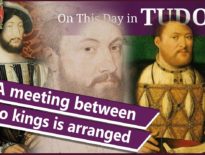On this day in Tudor history, 15th October 1584, schoolteacher and poet Richard Gwyn (Richard White), was hanged, drawn and quartered for high treason at Wrexham in Wales due to his Catholic faith.
Find out about Richard Gwyn's life, how an attack by crows and kites made him steadfast in his faith, his arrest and downfall, his works, and the legends associated with his death, in today's talk.
Also on this day in Tudor history, 15th October 1537, Prince Edward ( future King Edward VI), son of King Henry VIII and his third wife, Queen Jane Seymour, was christened in a lavish ceremony in the Chapel Royal at Hampton Court Palace. He was three days old. Find out more about the ceremony, godparents and gifts in last year’s video:
Also on this day in history:
- 1536 – Henry VIII wrote to the Earl of Shrewsbury, the Duke of Suffolk “and others” with instructions on handling the rebellion which we now know as the Pilgrimage of Grace. The King also wrote to the rebels in Lincolnshire promising “to show them mercy if they leave all their harness and weapons in the market-place of Lincoln”.
- 1542 – Death of William Fitzwilliam, Earl of Southampton, courtier, diplomat and naval commander, in Newcastle-upon-Tyne. It is thought that he was buried in Newcastle. Southampton's offices included Vice Admiral, Treasurer of the Household and Lord Privy Seal. He died while leading troops to Scotland under the command of Thomas Howard, 3rd Duke of Norfolk.
- 1582 – The first day of the Gregorian calendar following the last day of the Julian calendar, 4th October 1582, meaning that the 5th-14th October did not exist in the year 1582. Many countries ignored Pope Gregory XIII’s papal bull and carried on using the Julian Calendar. England, for example, did not introduce the Gregorian calendar until 1752.
- 1590 – Death of William Bleddyn (Blethin), Bishop of Llandaff. He was buried in Matharn Church, in the chancel.
- 1595 – Death of Philip Howard, 13th Earl of Arundel, in the Tower of London. It was rumoured that his cook had poisoned him. Arundel had been imprisoned for high treason, because of his Catholic faith and for fleeing England without Elizabeth I's permission. He was buried in the Tower chapel, St Peter ad Vincula.
Transcript:
On this day in Tudor history, 15th October 1584, schoolteacher and Welsh language poet, Richard Gwyn, was hanged, drawn and quartered for high treason at Wrexham in Wales due to his Catholic faith.
Let me tell you a bit more about this Tudor Welshman…
• Richard Gwyn was born in around 1537 in Llanidloes, Montgomeryshire. His surname translates to White so he’s often referred to as Richard White.
• He was educated at Oxford and then Cambridge, where his studies were cut short due to his mentor and patron, the master Dr George Bullock, being deprived of his office. Gwyn returned to Wales and worked for 16 years in the Overton and Wrexham areas of North Wales as a teacher.
• He married Catherine, who was from Overton, and they went on to have six children, although only 3 of them outlived their father.
• The Bishop of Chester and his officers began to put pressure on Gwyn when it was noticed that he was abstaining from Protestant communion. Gwyn gave into the pressure at first but then one day as he came out of church he was attacked by crows and kites which persecuted him all the way home. He decided then to embrace the Catholic faith wholeheartedly.
• In 1578, Gwyn’s Catholic faith, his refusal to attend Protestant services and his support of missionary priests, led to him going into hiding. He was arrested in early 1579 by the Vicar of Wrexham, but managed to escape. He was arrested again in 1580 after mercer David Edwards tried to apprehend him, attacking him with a knife. It is said that Gwyn used his staff to hit Edwards on the head but was worried when he thought he’d killed him and so hung around until Edwards came round. Edwards got up and pursued Gwyn who was captured when some workers cutting hay in a nearby field joined the chase and surrounded Gwyn. He was then taken to Ruthin gaol. A few months later, he refused the deal of a pardon if he would go to church.
• In May 1581, Gwyn was taken to the church at Wrexham in shackles and chains to listen to the sermon. However, according to one account, “so stirred his legs that with the noise of his irons the preacher's voice could not be heard”. Afterwards, he was put in the stocks and taunted by the local Protestant clergy. One of them claimed to have the keys to heaven, to which Gwyn replied “There is this difference, namely, that whereas Peter received the keys to the Kingdom of Heaven, the keys you received were obviously those of the beer cellar.”
• In 1582, he was forced to listen to another Protestant sermon, but he and other Catholic prisoners heckled the preacher so much that the sermon was cut short.
• In the autumn sessions of 1584 in Wrexham, in a court presided over by Sir George Bromley, Chief Justice of Chester, on 9th October, Gwyn tried for high treason after being charged with, amongst other things, making rhymes against married priests, calling the Bible a babble, and defending the pope’s authority. He was tried with John Hughes and Robert Morris. Gwyn and Hughes were found guilty and Morris was acquitted. Hughes was then reprieved but Gwyn was sentenced to death. On hearing his sentence, he simply said “What is all this? Is it any more than one death?” Gwyn’s wife was also brought before the court and warned not to follow her husband’s example, to which she, with her baby in her arms, replied “If you lack blood, you may take my life as well as my husband's ; and if you will give the witnesses a little bribe, you may call them ; they will bear evidence against me as well as they did against him.” She was imprisoned temporarily.
• On 13th October, Gwyn was offered his life in return for acknowledging the queen’s supremacy, but he refused.
• On 15th October 1584, Gwyn was led out of the gaol for his execution, comforting those he passed who were weeping, telling them “Weep not for me, for I do but pay the rent before the rent day”. He then gave silver to the poor at the prison door, and gave his wife money and his beads, blessing the baby in her arms.
He was then drawn on a sled to the place of execution, the beast market in Wrexham, praying the rosary all the way. The heavens opened as he started his journey, with the rain apparently not stopping until he had died. When he arrived at the gallows, he spoke to those gathered, saying “God is merciful to us, behold the elements shed tears for our sins.”
After he had climbed the ladder, he said to the crowd, “I have been a jesting fellow, and if I have offended any that way, or by my songs, I beseech them for God’s sake to forgive me.”
The executioner, who was also Gwyn’s gaoler and who had been kind to him during his time in prison, tried to put an end to Gwyn’s suffering by pulling in his legs while he was hanging, but it didn’t work, and he had to suffer the full traitor’s death while still conscious. His last words in Welsh translate to “Jesus, have mercy on me.”
His head and one of the quarters of his body were displayed at Denbigh Castle and the other three parts sent to Wrexham, Ruthin and Holt.
• Gwyn’s works include a series of five carols defending the Catholic faith and which were written in his final years, and a funeral ode.
• Gwyn, who is considered the first Welsh Elizabethan martyr, was beatified in 1929 and canonised in 1970 by Pope Paul VI as one of the Forty Martyrs of England and Wales.
• According to one story, Bromley, the judge who sentenced him to death, became an idiot, the clerk who read out his indictment went blind, the deputy justice died soon after, Edwards who helped capture him died an awful death, and the court crier was struck dumb and became a fool.



Leave a Reply